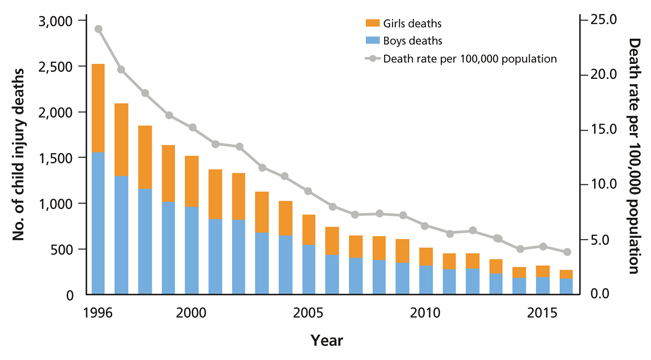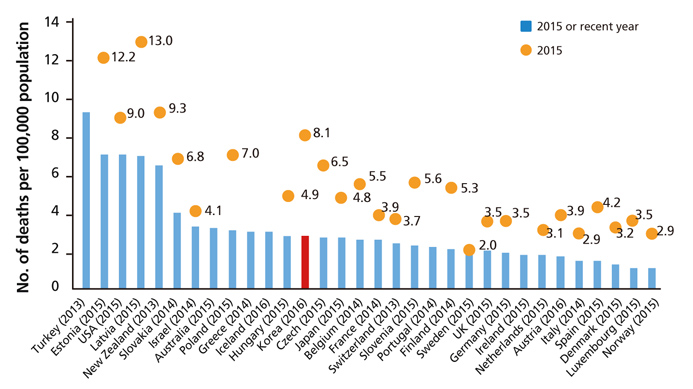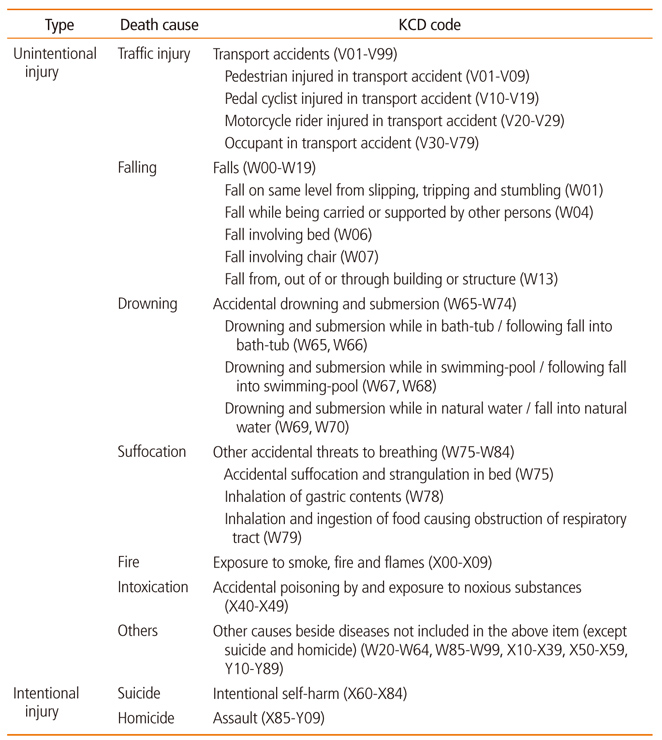 |
 |
- Search
| J Korean Med Assoc > Volume 62(5); 2019 > Article |
|
Warning: DOMDocument::load(): Namespace prefix xlink for href on media is not defined in /home/virtual/jkma/xmls/JKMA-62-283.xml, line: 516 in /home/virtual/jkma/journal/journal/include.xml.php on line 13
Warning: DOMDocument::load(): Namespace prefix xlink for href on media is not defined in /home/virtual/jkma/xmls/JKMA-62-283.xml, line: 516 in /home/virtual/jkma/journal/journal/include.xml.php on line 17
Vital Statistics Division, Statistics Korea, Shin, Lee, Kim, Lee, and Huh: Child injury death statistics from 2006 to 2016 in the Republic of Korea
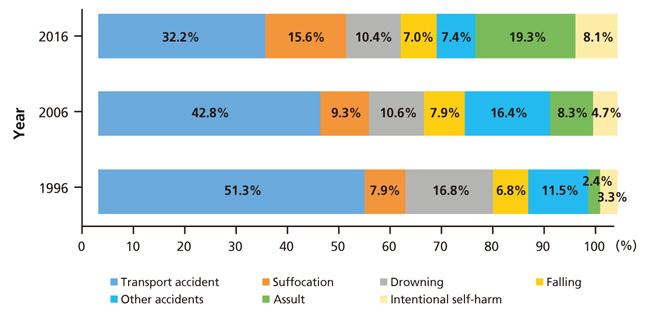
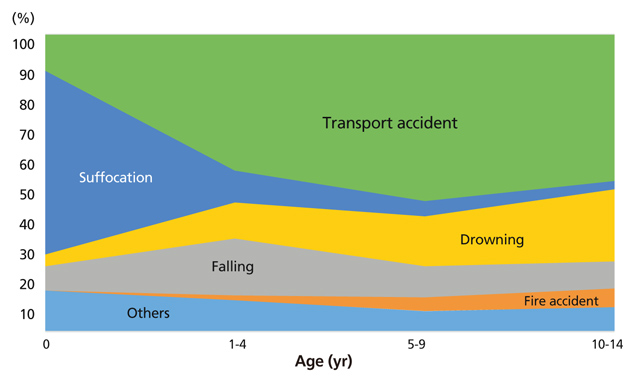
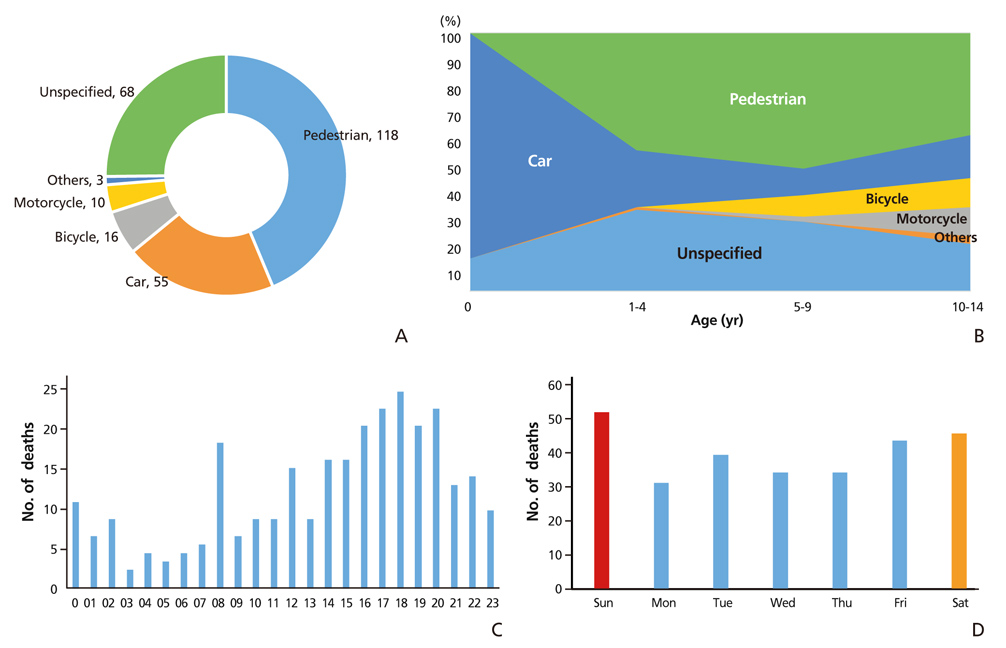
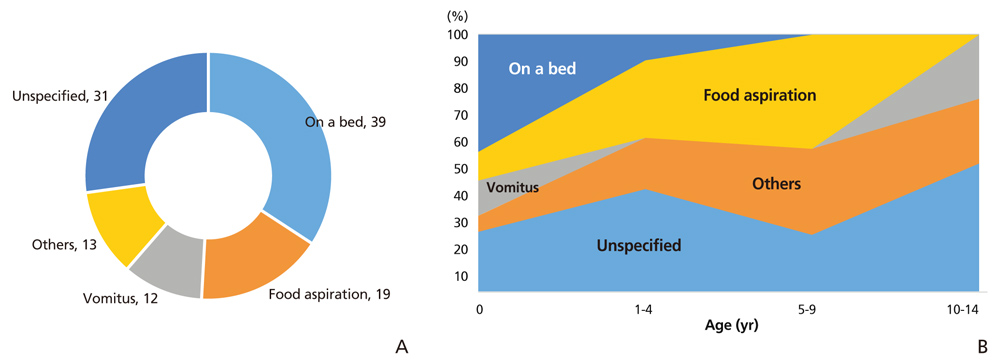

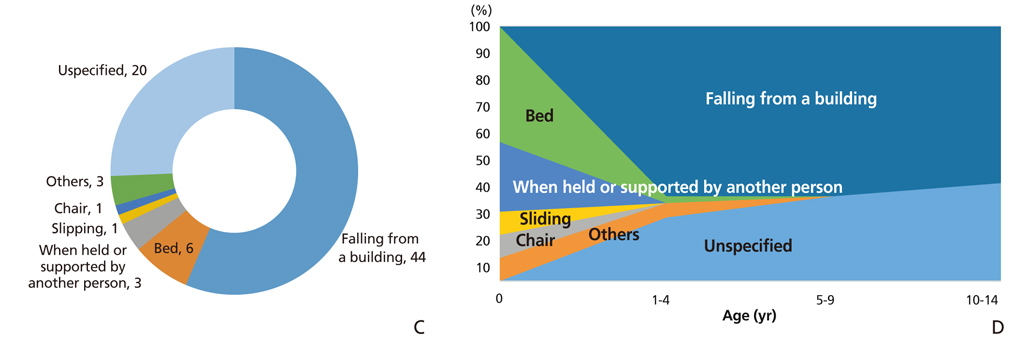
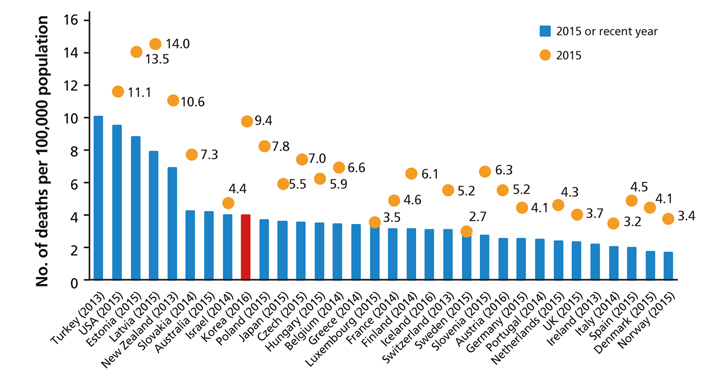
Abstract
This study aimed to analyze changing trends in child injury deaths from 2006 to 2016 and to provide basic data for initiatives to help prevent child injury deaths through improvements in social systems and education. Specific causes of death were analyzed using micro-data of the death statistics of Korea from 2006 to 2016, which were made available by Statistics Korea. Types and place of death were classified according to the KCD-7 (Korean Standard Classification of Diseases and Causes of Death). The data were compared to those of other Organization for Economic Cooperation and Development countries. Changing trends were presented. The number of child deaths by injury was 270 in 2016. The death rate was 8.1 per 100,000 population in 2006, while it was 3.9 in 2016. The death rate of boys was 1.7 times greater than that of girls. Unintentional injury deaths comprised 72.6% of all child injury deaths in 2016, while intentional injury deaths comprised 27.4%. The first leading cause of unintentional injury deaths in infants (less than 1-year-old) was suffocation, while that of children aged 1 to 14 years was transport accidents. The second leading cause of death in infants was transport accidents, that of children aged 1 to 4 was falling, and that of children aged 5 to 14 was drowning. Pedestrian accidents comprised 43.7% of the transport accidents from 2014 to 2016. To prevent child injury deaths by both unintentional and intentional causes, nation-wide policy measures and more specific interventions according to cause are required.
In the cause-of-death statistics from 2016 in the Republic of Korea, injury deaths, including those caused by transport accidents, falls, unintentional drowning, intentional self-harm, and homicide, comprised 2.2%, 25.1%, and 55.0% of deaths in the age groups of 0, 1-9, and 10-19 years, in which the number of deaths was 1,707, 1,043, and 1,462, respectively [1]. In Korea, an analysis was conducted of unintentional injuries in people aged less than 20 years through data of the National Emergency Department Information System of Korea from January 2010 to December 2011, which reported that “Most (94.1%) injuries were unintentional while 5.9% were intentional. The mortality rate was 5.4 per 100,000. The mortality rate of pediatric unintentional injuries was 0.1% including the prehospital deaths and emergency department deaths” [2]. In another study, 17,105 injured children younger than 15 years of age who visited the emergency room of a single hospital in Korea from June 2011 to May 2013 were analyzed. Among severely-injured patients, the most common place of injury was roads (50.00%, P=0.009), and the most common mechanism of injury was traffic accidents (50.00%), followed by falls (31.82%) (P=0.011) [3]. In 2004, the injury death rate in children younger than 15 years of age was 10.8 per 100,0000 (639 boys and 393 girls). The most frequent cause was transport accidents (38.0%), followed by drowning (21.2%), falling (13.7%), suffocation (13.3%), burning (6.3%), and poisoning (3.2%). The most common cause was suffocation in infants (less than 1-year-old), falling in 2-year-olds, drowning in 3-year-olds, and transport accidents in 1- and 4-year-olds [4]. Beyond the above data, few studies have investigated child injury deaths in Korea. Most child injury deaths are preventable by taking appropriate measures and implementing suitable safety systems in the environment. For example, to prevent accidents at home, the dissemination of a manual or booklet entitled the “New parent information kit” is recommended. To prevent bicycle accidents, the need to wear a helmet and to use a coaster brakes should be emphasized, and parents and children should be educated on this topic [5].
Child injury is one of the most important public health issues in the world [6]. Unintentional accidents are the most common cause of child deaths worldwide [7]. Although there was a decrease in child injury deaths after 2003, when the Korean Government initiated a nation-wide child safety system, we should strive further to reduce child injury deaths to provide a safer life for children.
Basic data on child injury deaths are mandatory in order to develop and implement prevention preventable measures or policies. Therefore, we analyzed child injury deaths using micro-data from the death statistics of Korea from 2006 to 2016, which were made available by Statistics Korea.
Ethics statement: No institutional approval or informed consent was required because this was an analysis of publicly available data that were produced by Statistics Korea according to the Bioethics and Safety Act.
Study design: This study was a public database-based analysis.
Data source and analysis: The data in this article were drawn from micro-data of the death certificates issued in 2016 for Korean people who resided in Korea, available from: https://mdis.kostat.go.kr. In order to compare the data internationally, the causes of death were classified according to the International Statistical Classification of Diseases and Related Health Problems, 10th revision, as recommended by the World Health Organization, as well as the Korean Standard Classification of Diseases and Causes of Death (KCD-7), which has been modified to fit circumstances in Korea, as described in a previous report [1]. Children were defined as the age group from 0 to 14 years old. Children were divided into age groups of 0 (infants), 1-4, 5-9, and 10-14 years for comparison with data from other Organization for Economic Co-operation and Development (OECD) countries. Deaths caused by accident were classified into intentional and unintentional accidents (Table 1). Intentional accidents comprised homicide and intentional self-harm. Unintentional accidents comprised transport accidents, falling, drowning, suffocation, fire, poisoning, and other causes of accidents besides diseases.
The death rates of OECD countries were obtained from the World Health Organization Mortality Database, available from: https://www.who.int. Only data from the 32 OECD member countries were compared.
Type and place of accident were collected according to the KCD-7 (Table 1). Specific causes were classified as follows: transport accidents (V01-V999), falling (W00-W19), drowning (W65-74), suffocation (W75-84), fire (X00-09), poison (X40-49), other accidents (W20-W64, W85-99, X10-X39, X50-X59, Y10-Y89), intentional self-harm (X60-X84), and homicide (X85-Y09). Death certificates with no concrete description of the type or place of accident or with a statement that the cause of death had not been identified were treated as unspecified.
Statistical analysis: Descriptive statistics was used.
The child injury death rate was 3.9 per 100,000 population, which was half of that in 2006 (8.1) (Suppl. 1). In 2016, the total number of child deaths was 1,830, of which 270 (14.8%) were child injury deaths, which was one-third of the number observed in 2006 (738). The average number of child injury deaths per day was 0.7 in 2016, whereas it was 2 in 2006. The death rate of boys (4.9) was greater than that of girls (2.8) in 2016. In 2016, the rate of boys was 9.1 and that of girls was 6.9 (Figure 1, Suppl. 2).
Unintentional injury deaths comprised 72.6% of all child injury deaths in 2016, while intentional injury deaths comprised 27.4%. The corresponding percentages were 87.0% and 13.0%, respectively, in 2006. Of the unintentional injury deaths, transport accidents (32.3%) were the top-ranking cause. Of the intentional deaths, homicide (19.3%) was the most common cause. In contrast to the data from 2006, the composition of following causes decreased: transport accidents (−10.6%p), fire (−3.8%p), falling (−0.8%p), poisoning (−0.3%p), and drowning (−0.2%p). In contrast, the following causes increased: suffocation (+6.2%p), homicide (+11.0%p) and intentional self-harm (+3.4%p) (Figure 2). The child injury death rate by unintentional accidents was 2.8 per 100,000 population; while that by intentional accidents was 1.1. In comparison to 10 years ago, the unintentional death rate decreased by 4.2 (from 7.0) per 100,000 population, while that by intentional deaths did not change. Transport accidents had the highest death rate among the causes of unintentional death (1.2) (Figure 3, Suppl. 3). The death rate among boys was greater than that of girls by 3.8 times for fire, 3.4 times for drowning, and 2.6 times for transport accidents (Suppl. 4).
From 2014 to 2016, the ranking of the causes of death by unintentional accidents were as follows: transport accidents (42.5%), suffocation (17.9%), drowning (14.5%), falling (12.3%), and fire (3.1%). For these 3 years, the number of child injury deaths by unintentional accidents was 636 and the rate was 3.0 per 100,000 population. The death rate was most common in the first year of life (10.5), after which the death rate decreased as age increased. The rate was 1.9 in children aged 10-14 years (Suppl. 3). The top-ranking cause of child injury deaths was suffocation in the first year of life, and transport accidents in 1- to 14-year-olds. The second ranking was transport accidents in the first year of life, falling in 1- to 4-year-olds, and drowning in 5- to 14-year-olds (Figure 2).
Pedestrian accidents accounted for 43.7% of child deaths in transport accidents. In 2014-2016, the total number of deaths of children by transport accidents was 270, and the death rate by transport accidents was 1.3 per 100,000. The death rate of boys (1.6) was higher than that of girls (0.9). The death rate by transport accidents (1.5) was the highest in the age group of 1- to 4-year-olds (Suppl. 5). The death rate by transport accidents decreased the most in the age group of 1-4 years, from 5.8 in 2004-2006 to 1.5 in 2014-2016 (Suppl. 6). The causes of death among children in the category of transport accidents were as follows: pedestrians (43.7%), vehicle occupants (20.4%), bicycle occupants (5.9%), and motorcycle occupants (3.7%). Overall, 50.4% of all child injury deaths caused by transport accidents occurred between Friday and Sunday. Transport accidents occurred most frequently at 4-8 p.m. (38.1%) and 8 a.m. (6.3%) (Figure 4).
Choking in bed comprised 34.2% of child deaths by suffocation. In 2014-2016, the number of suffocation deaths was 114, and the death rate by suffocation was 0.5 per 100,000 population. The death rate by suffocation was highest in the first year of life (6.5). In 2014-2016, the most common type of child suffocation was choking in bed (34.2%), followed by food inhalation (16.7%) and inhalation of gastric contents (10.5%) (Suppl. 7).
Choking in bed occurred by suffocation from a pillow, the mother's body, or a bedspread. Inhalation of food causes airway pressure or obstruction due to food (including bones or seeds). Inhalation of stomach contents also causes airway pressure or obstruction due to vomitus (Figure 5).
The child death rate due to drowning decreased from 1.5 in 2004-2006 (1.5) to 0.4 in 2014-2016 (Suppl. 8). Drowning in natural water, such as a stream or river, comprised 30.4% of child deaths by drowning, while drowning in bathtubs comprised 7.6% of such deaths and drowning in swimming pools, 5.4%. In 2014-2016, the number of deaths from drowning was 78, and the death rate from drowning was 0.4 per 100,000 population. The mortality rate of boys (0.6) was 2.8 times higher than that of girls (0.2). The death rate by drowning accidents in the 0- to 9-year-old age group was 0.4, while that of the 10- to 14-year-old age group was the highest (0.5) (Suppl. 9). Deaths in children aged under 5 years old were mainly caused by bathtubs, while in older children, drowning in natural water became the most common cause (Figure 6).
Falling from a building comprised 56.4% of child deaths from falling, while falling from bed comprised 7.7% of deaths and falling when held or supported by another person, 3.84%. In 2014-2016, the number of deaths from falling was 213, and the death rate from falling was 0.8 per 100,000 population (Suppl. 10). The death rate by falling accidents in the 0- to 9-year-old age group was 0.6, while it was 0.2 in children aged 10-14 years. Falling deaths in children aged under 5 years old were caused mainly by falls from buildings, from bed, and when held or supported by another person. In older children, such deaths were mainly caused by falls from buildings (Figure 7, Suppl. 11). The child death rate caused by falling decreased from 0.8 in 2004-2006 to 0.4 in 2014-2016 (Suppl. 10).
In 2015 or the most recent available year, the average child injury death rate in the 32 OECD countries was 3.7, while that of Korea was 3.9, which was the ninth highest rate. In 2005, the average child injury death rate of the 26 OECD countries was 6.3, while that of Korea was 9.4, which was the fifth highest rate (Figure 8, Suppl. 12). The average unintentional child injury death rate of the 32 OECD countries in 2015 (or the most recent year) was 3.1 per 100,000 population; while that of Korea was 2.8, which was the 12th highest rate. In 2005, the average rate in the 26 OECD countries was 5.5, while that of Korea was 8.1, which was the fifth highest rate (Figure 9, Suppl. 13).
Korea has been regularly making efforts to improve the laws and systems related to children's safety since the government declared the first Year of Child Safety in 2003. The Korean government has upgraded safety measures for children 4 times and improved the system evaluation and tasks. In order to prevent transport accidents, Korea needs to execute the following policies more strictly: improving the school bus system; strengthening the use of traffic signals in school zones; more stringently applying the policy of mandatory seat belt use by all passengers in a car and helmet use when riding a bicycle or autobicycle [9]; implementing safety training for drowning, mandatory swimming training starting in elementary school, and education for fall prevention; and strengthening initiatives related to public relations, inspection of safety facilities, safety glass-reinforced windows, and locks.
More active measures need to be taken to prevent deaths caused by transport accidents, falling, and suffocation because the infant injury death rate in Korea was higher than the average rate of OECD countries although injury death rate of 1- to 14-year-olds was not higher (Suppl. 12). In order to develop and implement interventions to prevent child injury death, we should define the problem, identify causes, develop and test interventions, and go through the process of nationwide adoption [6]. To prevent child injury deaths, a safety system should be constructed that accounts for children's age and sex, in a way that fits circumstances in Korea.
This study investigated statistics on child injury deaths in Korea from 2006 to 2016, presenting an interesting analysis of death certificate data for the Korean population, as death certificates are a representative statistical indicator in Korea. Furthermore, this paper reports noteworthy findings regarding trends in the mortality rate from injury deaths in children in the last 10 years. The most significant change in this period was the reduction in child injury deaths. Reductions in unintentional injuries, such as traffic accidents, burns, and falls, made a major contribution to this trend. It is also interesting that many traffic accidents affected pedestrians, and that many deaths occurred due to suffocation in bed. However, the rate of child injury deaths in Korea is still higher than in most other OECD countries, indicating that there is room for further improvement. This paper is considered to be a valuable resource that provides information on the health status of Korea and can serve as a useful reference material for researchers in this field.
[Editorial by Editorial Board]
Supplementary Materials
Supplementary materials are available from https://doi.org/10.7910/DVN/X6CI4I, Harvard Dataverse.
Suppl. 1. The number of child injury deaths and death rate from 1996 to 2016 in Korea
Suppl. 2. The number of child injury deaths, compo-sition, and death rate by cause in 1996, 2006, and 2016 in Korea
Suppl. 3. The number of child deaths, composition, and death rate by unintentional injuries by age from 2004-2006 to 2014-2016 (in 3-year periods) in Korea
Suppl. 4. The number of child deaths, composition, and death rate by traffic injuries from 2004-2006 to 2014-2016 (in 3-year periods) in Korea
Suppl. 5. The number of child deaths and composition by the type of traffic injury from 2014 to 2016 (in 3-year periods) in Korea
Suppl. 6. The number of child deaths, composition and death rate due to traffic injuries from 2004 to 2016 (in 3-year periods) in Korea
Suppl. 7. The number of child deaths and composition by the type of suffocation injuries from 2014 to 2016 (in 3-yera periods) in Korea
Suppl. 8. The number of child deaths, composition, and death rate due to drowning injuries from 2014 to 2016 (in 3-yera periods) in Korea
Suppl. 9. The number of child deaths and composition by the type of drowning injuries from 2014 to 2016 (in 3-yera periods) in Korea
Suppl. 10. The number of child deaths, composition, and death rate due to falling injuries from 2014 to 2016 (in 3-yera periods) in Korea
Suppl. 11. The number of child deaths and compo-sition by the type of falling injuries from 2014 to 2016 (in 3-yera periods) in Korea
Suppl. 12. Unintentional child injury death rate per 100,000 population in OECD countries by age group in 2005 and 2015 (or most recent year)
Suppl. 13. Child injury death per 100,000 population by causes in 2015 or most recent year in OECD countries
References
1. Statistics Korea Vital Statistics Division. Shin HY, Lee JY, Kim JE, Lee S, Youn H, Kim H, Lee J, Park MS, Huh S. Cause-of-death statistics in 2016 in the Republic of Korea. J Korean Med Assoc 2018;61:573.


2. Jung JH, Kim DK, Jang HY, Kwak YH. Epidemiology and regional distribution of pediatric unintentional emergency injury in Korea from 2010 to 2011. J Korean Med Sci 2015;30:1625-1630.




3. Woo JH, Yang HJ, Lim YS, Cho JS, Kim JJ, Park WB, Jang JH, Lee G. Predictive indicators for the severity of pediatric trauma and the prevention of injuries according to the general characteristics and pre-hospital factors of severe pediatric trauma patients. J Trauma Inj 2014;27:43-49.
5. Kim KH. Child injury prevention: home injuries and bicycle injuries. J Korean Med Assoc 2008;51:230-233.

6. Sleet DA. The global challenge of child injury prevention. Int J Environ Res Public Health 2018;09. 04. 10.3390/ijerph15091921. [Epub].

7. Borse NN, Gilchrist J, Dellinger AM, Rudd RA, Ballesteros MF, Sleet DA. CDC childhood injury report: patterns of unintentional injuries among 0-19 year olds in the United States, 2000-2006 [Internet] Atlanta: Centers for Disease Control and Prevention. 2008;cited 2019 Apr 5. Available from: https://www.cdc.gov/safechild/images/CDC-ChildhoodInjury.pdf
8. UNICEF. A league table of child deaths by injury in rich nations. Florence: UNICEF; 2001.
Figure 2
Composition of causes of unintentional child injury deaths in 1996, 2006, and 2016 in Korea.

Figure 3
Composition of causes of unintentional child injury deaths by age from 2014 to 2016 in Korea.

Figure 4
Characteristics of child deaths due to traffic injuries from 2014 to 2016 in Korea. (A) Number of child deaths due to traffic injury by specific cause. (B) Composition of child injury death due to traffic injury by age . (C) Number of child deaths due to traffic injury by time (hours). (D) Number of child deaths due to traffic injury by day.

Figure 5
Characteristics of child injury due to suffocation injury from 2014 to 2016 in Korea. (A) Number of child injury deaths due to suffocation injury by specific cause. (B) Composition of child injury death due to suffocation injury by age from 2014 to 2016.

Figure 6
Characteristics of child injury due to drowning from 2014 to 2016 in Korea. (A) Number of child injury deaths due to drowning by specific cause. (B) Composition of child injury death due to drowning by age.

Figure 7
Characteristics of child injury due to falling injury from 2014 to 2016 in Korea. (A) Number of child injury deaths due to falling injury by specific cause. (B) Composition of child injury death due to falling by age.

Figure 8
Change of child injury deaths per 100,000 population in Organization for Economic Cooperation and Development countries in 2005 and 2015 (or most recent year).

-
METRICS

-
Related articles in
J Korean Med Assoc -
Cause-of-death statistics in 2020 in the Republic of Korea2023 February;66(2)
Cause-of-death statistics in 2018 in the Republic of Korea2020 May;63(5)
Malaria Situation in the Republic of Korea2000 August;43(8)
Status of Vivax Malaria in the Republic of Korea2004 June;47(6)
Cause-of-death statistics in the Republic of Korea, 20142016 March;59(3)





